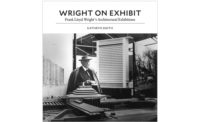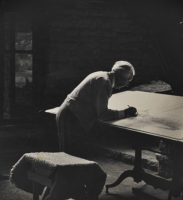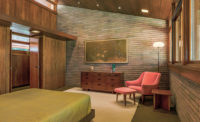New York's Museum of Modern Art offers a fresh look at the influential architect's ideas for skyscrapers and city planning.
| Photo: © Ezra Stoller/Esto |
| The exhibition is devoted to the city planning and skyscrapers of Frank Lloyd Wright, shown above in 1945. |
Frank Lloyd Wright's Broadacre City, conceived in 1934–35, was the emblematic manifesto of decentralized urban planning. Its first public viewing in New York's urbanistic heart, Rockefeller Center, was heralded by Architectural Record in its April 1935 issue, and commended by Lewis Mumford in The New Yorker the same month. Wright explained that his city would accommodate “little farms, little homes for industry, little factories, little schools, a little university . . .” in four square miles, with the acre as the basic unit for 1,400 families. Interestingly, Wright included skyscrapers in his plan—but they stood apart amid open space.
During his long life, Wright (1867–1959) continually railed against skyscrapers for gloomily crowding cities—and for being mere buildings, not “architecture.” But he didn't ignore the high-rise. He designed reinforced-concrete alternatives to steel-frame structures hung with masonry beginning as early as 1913 with an unrealized, Sullivanesque, 24-story tower for The San Francisco Call newspaper. In 1956, Wright capped his career with his scheme for the Mile High Illinois project for Chicago, where an elongated spire tops off its 548 stories.
Now Wright's projects representing two seemingly opposite obsessions—one, the skyscraper, the other, decentralized city planning—can be seen at New York's Museum of Modern Art (MoMA) in the show Frank Lloyd Wright and the City: Density vs. Dispersal, open until June 1, 2014. The exhibition celebrates the arrival of the Frank Lloyd Wright Foundation Archives at MoMA and the Avery Architectural and Fine Arts Library at Columbia University. The two institutions jointly acquired the archives in 2012, with the understanding that MoMA would keep the models and other three-dimensional objects, while drawings and photos would be housed at Avery. The show brings together the two collections organized by both institutions, led by Barry Bergdoll, acting chief curator of architecture and design at the museum and a professor at Columbia, and Carole Ann Fabian, director of the Avery Library. Also working with Bergdoll and Fabian were Janet Parks, curator of drawings and archives, Avery Library, and Phoebe Springstubb, curatorial assistant, department of architecture and design, MoMA.
In the handsomely installed show, the Broadacre City model, 12½ feet square, sits at the center of the gallery like a raised carpet. Dark taupe walls offset Wright's lush drawings of his towers, often faintly rendered. As Wright continually looked for ways to open up the skyscraper to light and air, he experimented with massing, plan, and materials: in his unbuilt National Life Insurance Company Building for Chicago (1924–25), iridescent glass clads four connected, reinforced-concrete towers where floor plates cantilever from central pylons. In the exhibition, a faintly polychromatic axonometric of the glass curtain wall is reproduced on an LED screen so that it luminously glows within the frame.
Also on display, Wright's sections and plans for St. Mark's-in-the-Bouwerie Tower in New York (1927–31) reveal cantilevered concrete floor slabs branching out organically from a central core. A short film, Tower of Glass (circa 1950), arrestingly documents the completion of Wright's reinforced-concrete-with-cantilevered-slab S.C. Johnson & Son Research Laboratory Tower in Racine, Wisconsin. A model of the H.C. Price tower, in Bartlesville, Oklahoma, 1956—second (and last) of Wright's tall building projects to be realized—looms nearby. At 6½ feet high, it demonstrates well the exterior's architectonic quality, generated by his signature pinwheel floor plans. Another Wright feature—the atrium within the tower—is illustrated by drawings of the unbuilt Rogers Lacy Hotel in Dallas, 1946–47. As Bergdoll points out, the concept anticipated hotels spawned later by John Portman.
Wright based his spread-out Broadacre City on a small-is-good ethos, in which “every citizen” had a car. But he divided transportation onto levels, separating trucks, buses, cars, long-distance monorail, and pedestrians. Houses were fireproof synthetic prefab units that also incorporated natural materials; roofs were copper. Yet hovering over this low-density community were skyscrapers. How so? In 1931 Wright contended, “The skyscraper is no longer sane unless in free, green space.” The towers' problem arose when they were crammed into cities like New York—unwieldy symbols of greedy commerce. So he made sure his skyscrapers were sparsely distributed in Broadacre City—surrounded by open land.
In 1956, Wright designed the Mile High Illinois—another scheme with a concrete core, but aided by suspension cables at the edges of the floor slabs, and rising from a deeply embedded “taproot” foundation. His choice of the city—Chicago—for the project may seem disingenuous. But Wright planted the tapering structure in a large greensward on the city's Gold Coast.
As Bergdoll conjectures about Wright's fascination with tall buildings, “He couldn't give it up. Wright felt he could make skyscrapers into architecture.” Now one only need look at the Burj Khalifa in Dubai by Adrian Smith for Skidmore, Owings & Merrill, or Smith's and Gordon Gill's under construction in Jeddah, to see Wright's profound influence. While Broadacre City is blamed today for America's overwhelming sprawl, Wright's elegant solutions to the skyscraper, no matter how high, show that the tall building could be artistically considered—as Louis Sullivan, his mentor, so fervently wished. Despite the twinning of Wright's obsessions, density won over dispersal.











Post a comment to this article
Report Abusive Comment